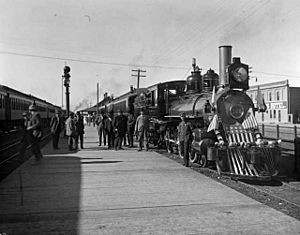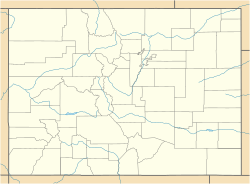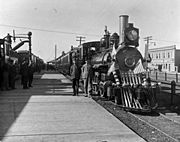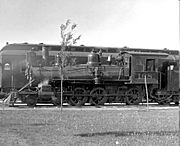Rio Grande 168 facts for kids
Quick facts for kids Denver and Rio Grande Western No. 168 |
|
 |
|
| D&RG No. 168 at the head of a special train taking William Howard Taft to the opening of the Gunnison Tunnel in 1909 | |
| Power type | Steam |
|---|---|
| Reference | |
| Builder | Baldwin Locomotive Works |
| Serial number | 6670 |
| Build date | 1883 |
| Rebuild date | 2016–October 2019 |
| Configuration | 4-6-0 |
| UIC classification | 2′C n2 |
| Gauge | 3 ft (914 mm) |
| Driver diameter | 46 in (1,168 mm) |
| Length | 53.3 ft (16.2 m) |
| Weight on drivers | 50,643 lb (23.0 t) |
| Locomotive weight | 70,550 lb (32.0 t) |
| Locomotive and tender combined weight | 117,950 lb (54 t) |
| Fuel type | Coal |
| Boiler pressure | 160 psi (1 MPa) |
| Cylinders | Two |
| Cylinder size | 14 in × 20 in (356 mm × 508 mm) |
| Tractive effort | 11,590 lbf (51.55 kN) |
| Retired | 1938 (revenue service) |
| Restored | October 2019 |
| Current owner | The City of Colorado Springs, Colorado Cumbres and Toltec Scenic Railroad (operator) |
| Disposition | Operational, in occasional excursion service, based in Antonito, Colorado |
|
Rio Grande Engine No. 168
|
|
| Location | 9 S. Sierra Madre, Colorado Springs, Colorado |
| Area | less than one acre |
| Built | 1883 |
| Architect | Baldwin Locomotive Works |
| NRHP reference No. | 79000601 |
| Added to NRHP | August 10, 1979 |
Denver and Rio Grande Western No. 168 is a special steam locomotive. It's a "Ten Wheeler" type, which means it has a specific wheel arrangement: four small wheels at the front, six large driving wheels in the middle, and no wheels at the back. This design is also called a 4-6-0.
This locomotive is a "narrow-gauge" train. This means its tracks are closer together than standard tracks. It was one of twelve similar trains built in 1883. The famous Baldwin Locomotive Works built it for the Denver and Rio Grande Railroad (D&RG).
No. 168 was designed to carry passengers. It had very large driving wheels, about 46 inches across. These big wheels helped it travel faster, which was great for passenger service.
Contents
A Look at Its History
We don't know a lot about the daily work of locomotive 168. Most of what we know comes from old photographs.
Early Sightings
One photo from 1904 shows it in the beautiful Black Canyon of the Gunnison River. Another set of pictures shows it in 1909. In these photos, it was pulling a special train. This train was carrying President William Howard Taft. He was on his way to open the Gunnison Tunnel. At that time, this tunnel was the longest irrigation tunnel in the world!
Later photos, taken by Otto Perry, show the train in different towns. One was in Alamosa in 1923. Another was in Salida in 1929.
Retirement and Preservation
Locomotive 168 worked for 55 years. It was retired in 1938. This was later than most other trains of its kind.
On August 1, 1938, the railroad gave the train to the City of Colorado Springs. In 1979, it was added to the National Register of Historic Places. This means it's an important historical item.
For many years, the train sat in Antlers Park. It was outside, not protected from the weather. But when it was moved for restoration in 2016, it still looked amazing.
Bringing No. 168 Back to Life
The City of Colorado Springs made a deal with the Cumbres and Toltec Scenic Railroad (C&TSRR). They agreed to fix the engine so it could run again. The locomotive is now in Antonito, Colorado.
The Restoration Project
The restoration work finished in October 2019. The Cumbres and Toltec Special Projects team led the effort. Assistant General Manager Efstathios Papas was in charge.
The project cost $508,000. It took 27 months, which is over two years, to complete. The railroad plans to use this engine often. They want it to be part of their regular train service as much as possible.
-
In the Black Canyon of the Gunnison, 1904
Images for kids







